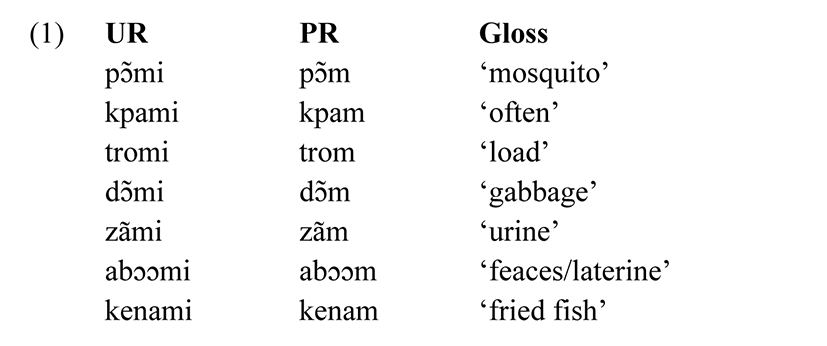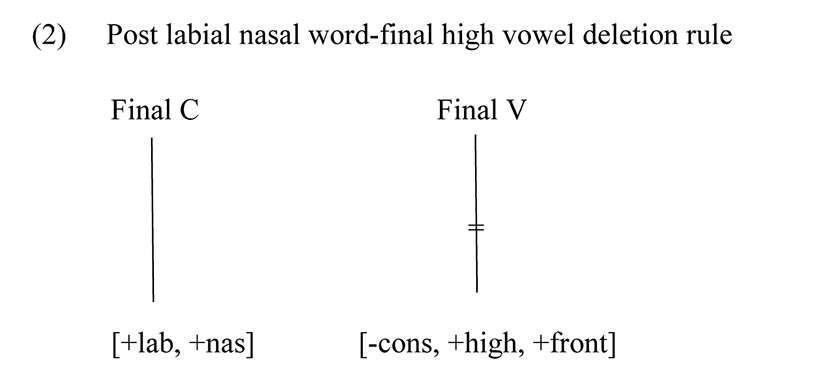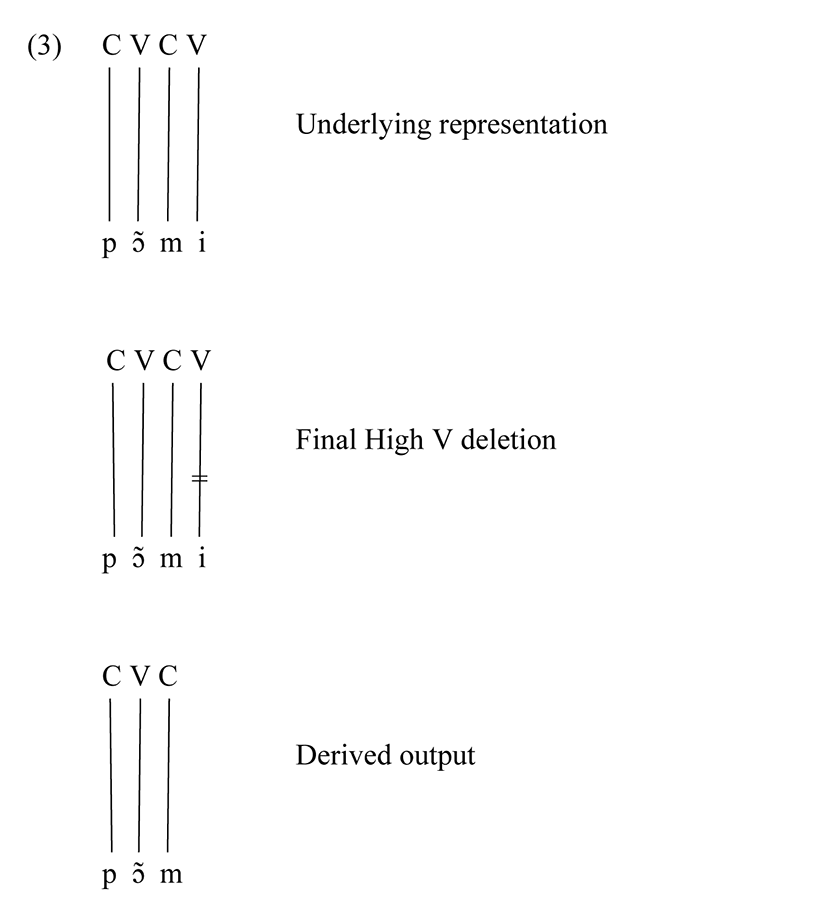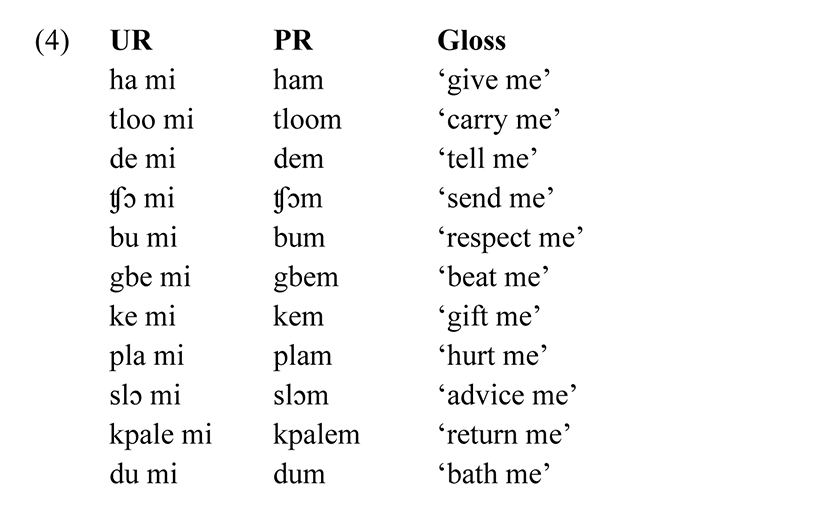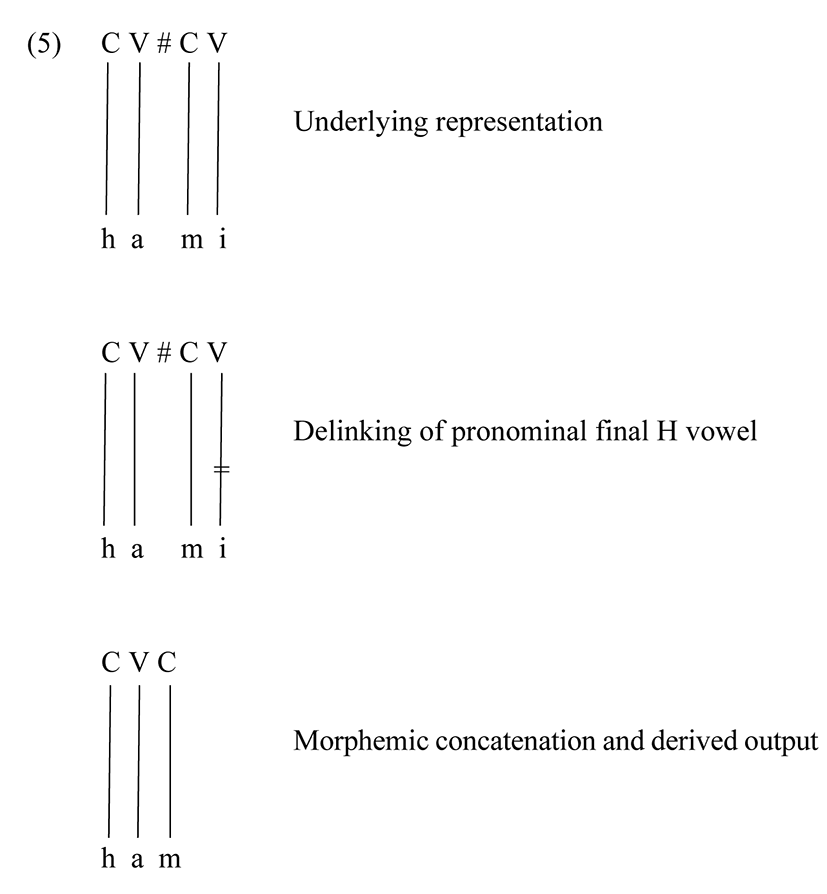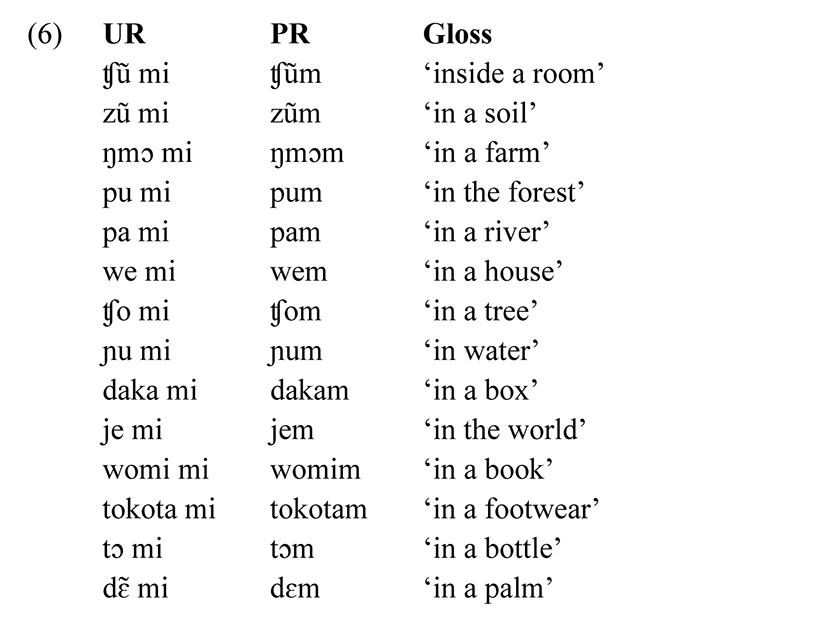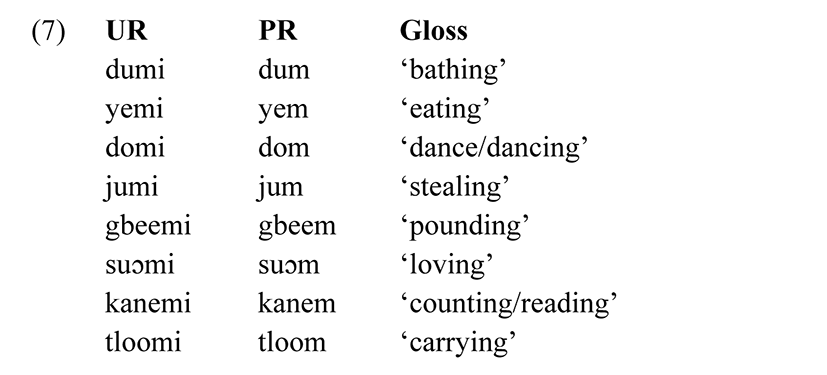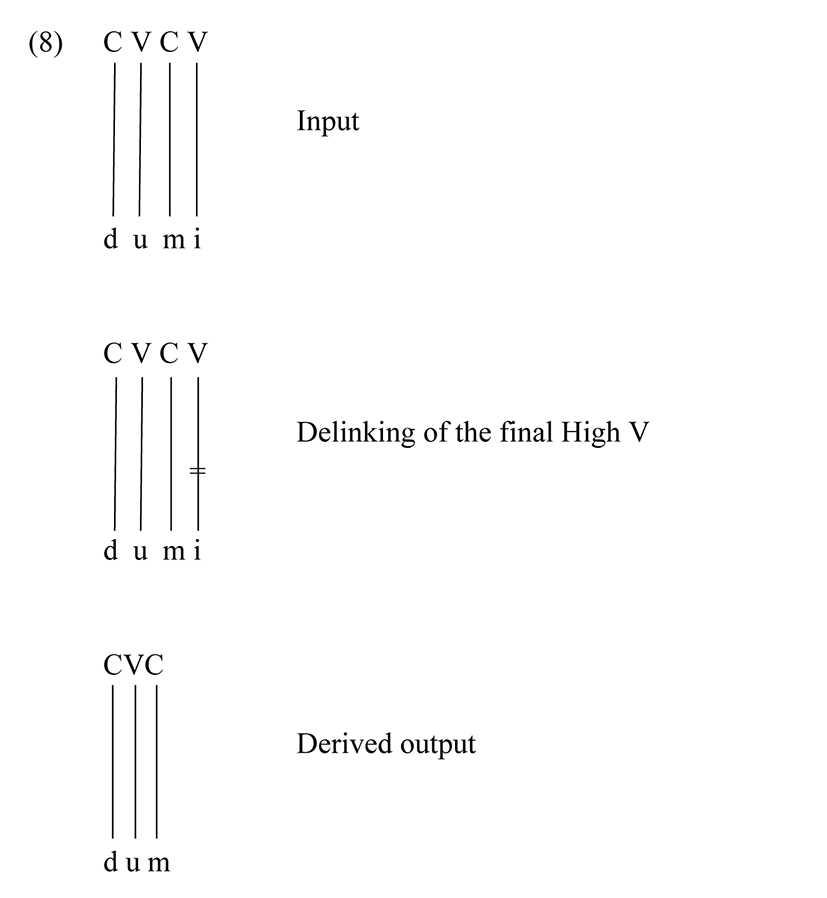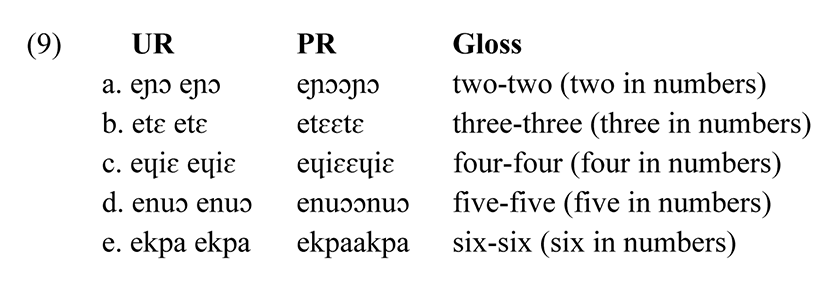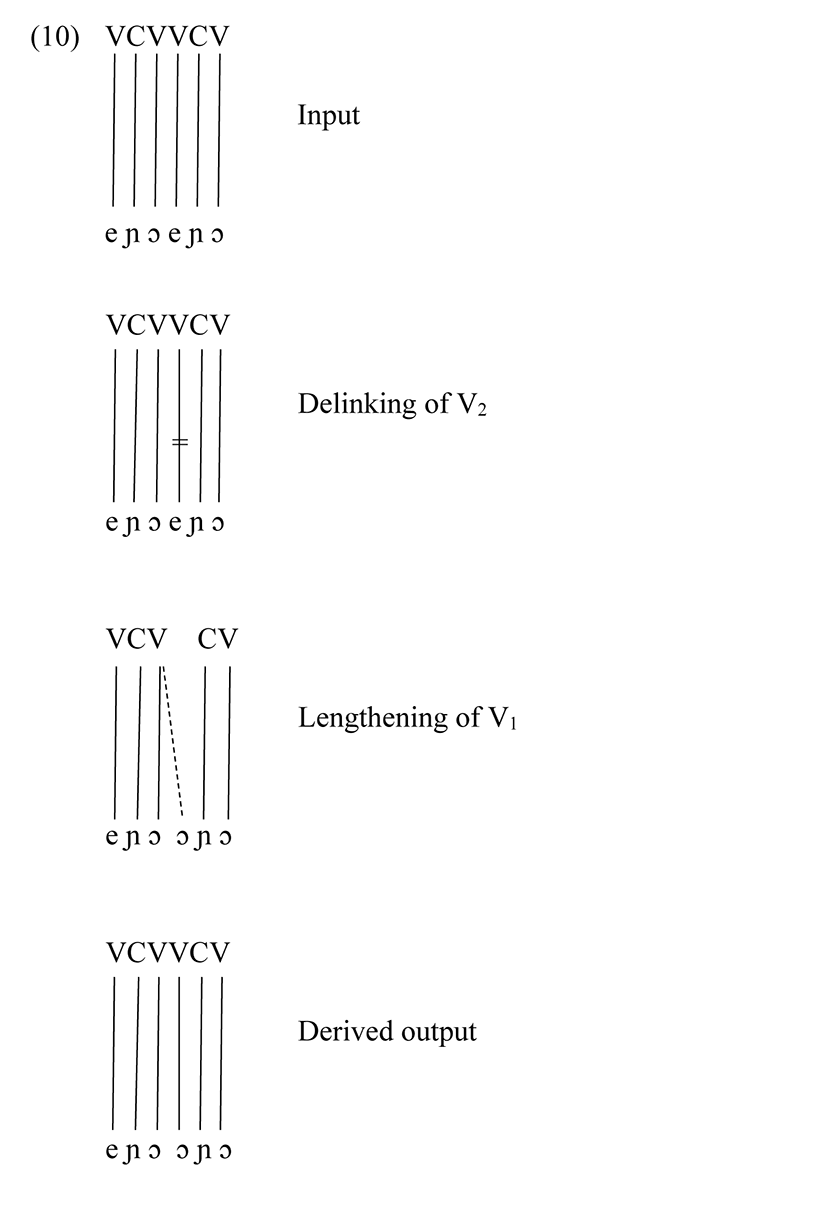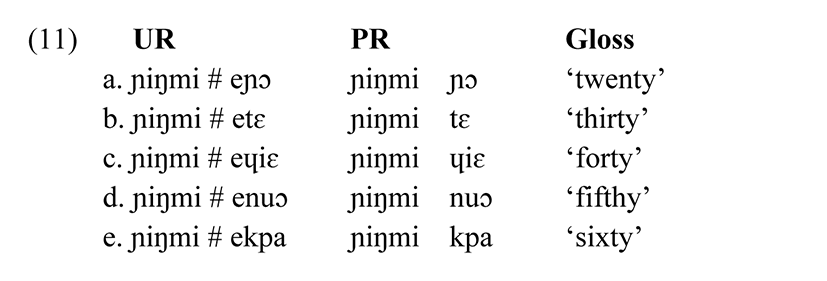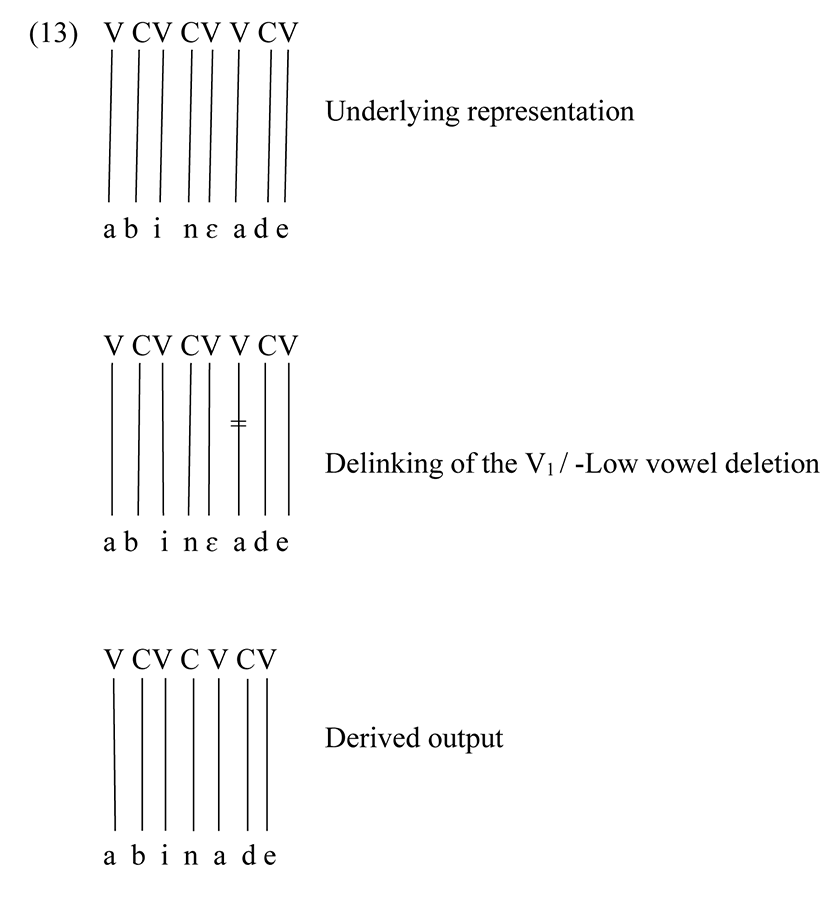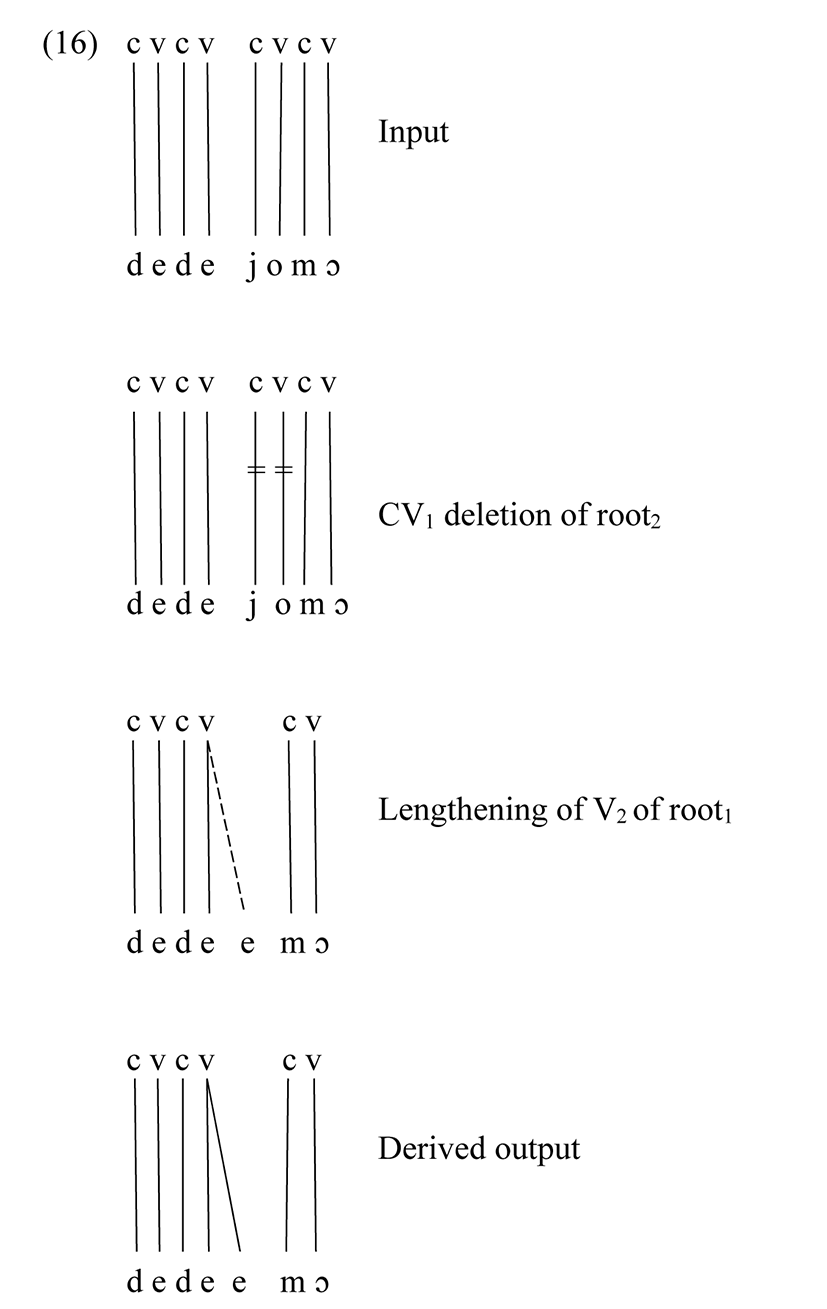1. Introduction
This study seeks to discuss some elision strategies in Dangme, a Kwa language. It discusses the processes involved in elision in Dangme and the operational contexts of elision in the said language. Elision is a syllable structure process that has gained erudite research attention in several languages including Black American English (Moran 1993), French (Morin 1986), Yoruba (Orie & Pulleyblank 2002), among several other languages. Ghanaian languages, too, are not exempt of this study. The said syllable structure process has been studied in Ghanaian languages including Fante (Abakah 2004), Dagbani (Abdul-Rahman 2013, Kwame 2018), Esahie (Owusu Ansah 2020) among others.
Elision can be seen as the process of omitting sounds or segments usually in connected speech as mentioned by Crystal (2008). Both consonants and vowels are possibly affected, and sometimes even the whole sound sequence may be elided (i.e., post-lexical representation), as stated by Katamba (1989: 277). Crystal (2008) also substantiates the case of elision being realized in connected speech where in addition to vowels and consonants, whole syllables may also undergo the process. The syllable structure process that operates in the earlier mentioned languages is also at play in Dangme. In Dangme, we observe some contextual environments where elision occurs, be it vocalic, consonantal and syllabic deletions which the study aims to account for. The study shows that in Dangme, syllabic and segmental elision are realized within a lexical item, morpheme or word boundary, and word finals. A crucial aspect of elision is its directionality especially at morphemic boundaries. At morpheme boundaries, Casali (1996) posits that vowel elision may target either the leftmost vowel in a sequence (henceforth V1) or the rightmost (henceforth V2) and mentions Dangme as one of the languages that conforms to this notion (cf. Dakubu 1987). This shows that elision in Dangme could be leftward or rightward at morpheme boundaries. Casali (ibid.) further explains that, the possibility of a single language demonstrating elision in both directions at morpheme boundaries is not uncommon. However, it is claimed from a cross-linguistic perspective that vowel elision in V1 is more common and productive than elision in V2. In terms of sheer frequency of occurrence, languages with V1 elision outnumber languages with V2 elision by more than two to one. Also, with the exception of only two languages, Kagate and Basque, Casali (1996) in his survey posits that every language with V2 elision also has V1 elision in at least some contexts and Dangme does not fall short of this postulation. It is worth reiterating that Dangme, determined by context, shows the operation of both V1 and V2 elision. We also show in this study, evidence of elision of word final vowels in Dangme as seen in several languages.
We further demonstrate that elision in Dangme is a morpho-phonological phenomenon as established in several other languages. Morphological factors that trigger elision in Dangme include compounding with specific reference to clause compounds, reduplication involving numerals, and nominalization. Some specific pronominal objects and postpositions at morpheme finals also trigger segmental deletion.
Dangme is a Kwa language of the Niger-Congo language phylum spoken in parts of the Greater Accra, Eastern and Volta Regions of Ghana. According to Akortia (2014), Dangme is taught in some basic schools in three out of the sixteen political regions in Ghana where the Greater Accra Region, which is estimated to have the highest number of speakers, is followed by the Eastern Region and the Volta Region. Caesar (2018) also adds that the Dangme people inhabit the coastal area of the Greater Accra Region, east of Accra, and part of the Eastern Region where they share a linguistic neighborhood with Ga, Akan and Ewe. Dangme has seven dialects which are Ada, Ningo, Kpone, Gbugbla, Osudoku, Shai and Krobo (Yilo and Manya) (Caesar 2019).
According to Caesar (2012), Dangme has twelve phonemic vowels. Seven of these are oral vowels /i, e, o, ɔ, a, ɛ, u/ which could be lengthened as /ii, ee, oo, ɔɔ, aa, ɛɛ, uu/ and five nasal vowels /ã, ĩ, ũ, ɔ̃, ɛ̃/. It is worth pointing out that the nasal vowels are in contrastive distribution with their oral counterparts. According to Dakubu (1987: 13), Dangme has an inventory of twenty-three consonants. The consonants are /p, b, m, t, d, f, v, s, z, n, ʧ, ʤ, gb, kp, ŋm, ɲ, k, g, ŋ, h, w, l, j /. All consonants can occur in the word's initial position, ranging from co-extensive to syllabic onsets.
Dangme is an open-syllabic language that has a V, CV, CCV, and C(N) syllable structure. The V syllable is composed of a vowel segment only which appears in pre-consonantal word initial environments whereby it occupies the nucleus slot without margins. In words like /a.kpe/ ‘thousand’, /e.ku/ ‘male’, /e.jo/ ‘female’ for instance, the word initial pre-consonantal vowels /a/, /e/ and /e/ respectively constitute the V syllable structure. The CV syllable structure is composed of a consonant being an onset and a vowel being a nucleus. There is also evidence of CCV structure in Dangme which demonstrates the applicability of consonant cluster in Dangme. This is achieved when a consonant is followed by a liquid and a vowel. This is a situation whereby the C2 of a C1C2V is specified for [+liquid] as in /pla/ ‘hurt’, /a.slɛ/ ‘comb’, /slɔ/ ‘advice’ etc. This is different in Akan where the liquid could have constituted a nucleus to the onset as a separate syllable leaving the V as another syllable peak. According to Dakubu (1987), Dangme is a CV syllable language with occasional syllabic consonants, usually the bilabial nasal /m/ that occurs at word final positions as in /lam/ ‘act of singing’, /fiɛm/ ‘act of playing’ (cf. Dakubu 1987). Other examples include /pam/, /tim/, /kom/ etc. which are mainly adverbs of manner or onomatopoeic words. This syllabic consonant could constitute a separate syllable peak as on several occasions, most of these word final syllabic consonants usually, the bilabial nasal /m/ have an underlying front high vowel /i/ in emphatic speech that has undergone elision in rapid speech. This means the bilabial nasal /m/ has been syllabified due to the elision of its nucleus /i/.1 This is what we label the C(N) syllable in Dangme.
Finally, Dangme, like other Kwa languages such as Akan and Ewe, is a register tone language. It has three level tones, which are contrastive. The three level tones in Dangme are high [ ́] as in /má/ ‘dough’ mid [ ̄ ] as in /mā/ ‘herrings’ and low [ ̀] as in /mà/ ‘town’.
2. Elision
One of the syllable structure changes that occur in rapid speech because of sounds influencing each other is elision (Owusu Ansah 2020). This process has become crucial to discuss since it is the focus of this study.
In the view of Matthews (1997), elision is a process by which a vowel at the end of a word is lost, or elided before another word at the beginning of that vowel follows. Among the several domains of elision, Mathews’ definition seems to touch on just a domain of the phonological process being discussed. This is where elision is realized at morpheme boundaries where vowel hiatus is created. Attested in several languages, vowel elision at morpheme boundaries could see the drop of either V1 or V2. But, the loss of the V1 is only what Matthews (ibid.) mentions in an attempt to define the process. As already mentioned, V1 is not the only V segment deleted at the morpheme boundary where the vowel hiatus is realized, but evidence from Akan as shown in Abakah (2004) and several other languages shown by Casali (1996), account for the possibilities of either the loss of V1 or V2 in the said environment which is defined by contextual factors. Besides morpheme boundary vowel elision, it is also worth pointing out the existence of word-final V deletion as part of the domains of vowel elision and occasionally word initial vowel elision.
Furthermore, in studies like Akan (Abakah 2004) and Esahie (Owusu Ansah 2020) among other Kwa languages, elision goes beyond simply removing only vowel segments, it also affects consonants, and even syllables in rapid speech as well as connected speech. Abdul-Rahman (2013) also shows evidence of word-final consonant deletion at the morpheme boundary to break the C1C2 cluster in Dagbani, a Gur language.
Abakah (2004) defines the syllable structure process for Fante as ‘a phonological process by which a vowel, a consonant and sometimes a syllable which is an intrinsic property of a morpheme in an isolative style, is dropped in the combinative style’. Abakah also confirms the postulation that, elision usually occurs in the combination of morphemes. Our discussion in the next sub-section adheres to this postulation. It shows that in Dangme, elision may occur in lexical items but usually at morpheme boundaries. The elision process also affects vowels, consonants and syllables.
This study adopts the use of Autosegmental linear phonological theory to demonstrate the formalization of the processes segments undergo for elision to be realized. Autosegmental phonology is a phonological theory propounded by Goldsmith (1976). Before the inception of autosegmental theory, earlier phonologists used linear generative phonology. According to Hyman (2011), it was observed by some scholars that linear generative phonology was unable to cater for some aspects of phonology such as suprasegments of which tone is an integral part.
It was decided that tone should be added to the segmental features as in Chomsky & Halle’s (1968) feature matrix structure. So, +/– HIGH was used for syllables with high tones, +/– FALLING was used for High-Low contour tone etc. It was later realized that, how the contour tones were represented in the feature matrix was problematic and adding the tonal feature to the features of the segment or a syllable in the feature matrix means tone is inherently part of the segment. Tones, too, are known not to be a feature of any segment, hence tones are autonomous and they were supposed to find another alternative to render tone autonomous.
Goldsmith (1976) realized that, the feature matrix under linear generative phonology could not satisfactorily cater for prosodic features of which tone is not an exception. This made Goldsmith (1976) propounded the autosegmental phonological theory as a remedy to the problem. Though the theory was propounded following some tonal issues, it has been expanded to featural and segmental analysis. Such studies include sound harmony (Clements 1977, 1981; Hoberman 1988), feature geometry (Clements 1985, Clements & Hume 1995) and prosodic morphology (McCarthy 1981, McCarthy & Prince 1986) among others.
The tools used in the Autosegmental Theory that helps this study to analyze the processes segments undergo to get elided include Association Lines which are formal devices that link autosegments on different tiers to each other. This tool links the CV tiers to their corresponding segmental tiers (cf. Evbuomwan & Edobor-Uzamere 2022). The feature spreading tool, which is used to show the spreading or assimilation of a feature of one sound to another sound in this case, is used to show an instance of compensatory lengthening when realized. The delinking tool, which is also used to show the deletion of a feature from a sound in this case, is used to delink the association between a sound and its CV tier. This shows the deletion of a particular sound.
3. Contexts of Elision in Dangme
In the following subsections, we discuss the contexts of elision in Dangme. In this discussion, we shall focus on the various segmental deletions which are vowel and consonantal deletions as well as syllabic deletions which are the general domains of this discussion. In vowel elision, it is shown that there is a deletion of the post-labial nasal word-final high vowel. This occurs in single stems, pronominal form in object environments, post-positions and nominalization. Also, in reduplicated numerals, the V2 is elided while some pre-consonantal vowels of some nominals are arbitrarily dropped without affecting the core meaning of the words. An instance of V1 elision in clause compounds is also shown in this discussion. In syllable deletion, we show a case of a CV drop in one domain and a CV drop coupled with compensatory lengthening in another domain as we finally discuss an instance of consonant deletion.
Vowels can be concatenated when two independent monomorphemic words are put together. When this occurs, one of the vowels may be elided (Owusu Ansah 2020). Just as posited by Ayagah & Ugochi (2021), there are both V1 and V2 elisions in Tiv2 depending on the context. Elision is one of the several strategies used for resolving hiatus when it is created through morpheme concatenation (Ayagah & Ugochi ibid.). According to Abakah (2004), in Fante, when a word that ends in a vowel is followed by another that begins with a vowel in the same breath group or phonological phrase, one of the resultant V1 # V2 sequences created at the morpheme boundary is truncated. These languages share a similar operation of the vowel elision phenomenon.
This is also true for Dangme. However, in Dangme, one of the common contexts of elision is the elision of H vowels at single and concatenated morpheme finals and in some cases word initial vowel elision just as is found in Akan (Abakah 2004). This shows that in Dangme, aside from elision at morpheme boundaries there is a common case of morpheme margins commonly morpheme ends and in rare cases morpheme initials. We begin our discussion with elision of post labial nasal word-final high vowels in the next section.
Elision of post labial nasal word-final high vowels basically involves an environment where a high vowel specifically [+front, +ATR] is dropped when it succeeds a labial nasal penult.
“When elision occurs in a given language, there is always loss of [word- or morpheme-] final vowels, but seldom loss of [word- or morpheme-] initial vowels. Furthermore, the loss of initial vowels is usually very limited in its statistical incidence.”
(Casali 1996: 12)
As earlier mentioned, one of the common contexts of vowel elision is the elision of vowels at morpheme ends. In Dangme, when a penultimate labial nasal /m/ is succeeded by a final V being specified for [+High, +front, +ATR] in its feature matrix, the final V elides. This operates in different morpho-phonological environments substantiating the assertion that elision is partially a morpho-phonological process This operates in the following environments in Dangme;
Vowel elision has been commonly known to surface in the concatenation of words as mentioned and shown in languages such as Fante (Abakah 2004), Esahie (Owusu Ansah 2020), Tiv (Ayagah & Ugochi 2021) among others. In Dangme, single stem words with a penultimate bilabial nasal consonant /m/ and a front high vowel usually see a deletion phonological process at play. In such a case, the CVC(N)V syllable composition where the C2 is specified for [+lab, +nas] and the final V is specified for [+High, +front] is reduced to a CVC(N). In such a context, the final H vowel is dropped for the penultimate bilabial nasal to surface as the final segment in the SR.3 It is worth noting that these words are not combination of different morphemes as commonly known. This is shown in example (1) below.
The data above shows some single stem words in Dangme with the final CV syllable specified for [+lab, +nas] for the C and the final V being specified for [+High, +front] in the underlying representation. In the phonetic form, the final H non-consonantal segment is deleted for the penultimate bilabial nasal to surface as the final segment. The phonetic form is achieved as a result of rapid speech or in casual speech.4 This process can be captured in the rule (2) below.
The above rule shows the disassociation or delinking of the final V as the final member of the stem boundary. As known in Goldsmith (1976) autosegmental phonology, and cited in Abakah (2004), it is assumed that any segmental feature matrix that is delinked from the autosegmental/timing tier is automatically deleted. So, the delinking of the association line that links the segmental tier labelled (final V) to its feature tier labelled ([-cons, +high, +front]) is automatically deleted leaving the final C ([+lab, +nas]) to surface as the final segment in the derivational output of the phonetic form. This is accounted for in the autosegmental representation in (3) below based on (1) above.
Pronominal forms in Dangme could function as subjects and objects just like they are unmarked in several languages. Such a context or construction also sees the operationalization of the elision process. Just like in Akan, Abakah (2004) posits that if a root morpheme terminates in a final -SV syllable (where S stands for non-vowel sonorant), the V deletes obligatorily if it has [+High] specification in its feature matrix; and one of the contexts in which this process operates is ‘pronominal forms in object environments’. A Similar case is evident in Dangme with a similar phonological process at play.
In Dangme, the first-person pronominal object form is /mi/ ‘me’ which is a CV(SV) with a sonorantal ([+lab, +nas]) and a vocalic ([+high, +front]) segmental composition. It is worth noting that this is a separate morpheme unlike what is discussed in (1) above. As this composition is a pronominal object, it is preceded by a verbal element to form a meaningful construction where a subject can be optional. In such a construction, both the verbal element and the pronominal object are concatenated in casual speech. This renders the pronominal CV as the final syllable of the construction where the deletion rule now operates. The final high V is now dropped for /m/ to surface as the final syllable and the clitic form of the pronominal object.
This is exemplified in (4) below.
In the examples above, we see a sentential construction comprising a verbal element and a pronominal object form that succeeds the verbal element. The pronominal form in the underlying representation is a CV syllable specified for [+cons, +lab, +nas] and [-cons, +high, +front] segmental composition. In the surface representation, the final H of the pronominal object element is elided for the initial sound /m/ of the pronominal object in the UR to surface as the final segment in the SR. This is captured in the autosegmental representation (5) below.
In the second stage of the representation above, we see a delinking of the final H of the pronominal object from its segmental tier indicating an automatic deletion. Both morphemes are then concatenated leaving the bilabial nasal /m/ as the final segment and morpheme of the construction.
One of the contexts in which a post bilabial nasal word final high V is deleted is the concatenation of a nominal element and the postposition /mi/ ‘inside’ in Dangme. The postposition ‘mi’ is used to show location thus ‘within’ or ‘inside’ something (cf. Caesar 2020). In the underlying representation or emphatic speech, these are separate words (the noun and the post-position). However, these are concatenated or connected in casual or rapid speech.
According to Abakah (2004), elision is seen as a “phonological process by which a vowel, a consonant and sometimes a syllable, which is an intrinsic property of a morpheme in an isolative style, is dropped in a combinative style”. Meaning sound segments being a core part of a morpheme have the tendency to be dropped when combined with other words as mentioned earlier in this study. Such a case is evident in this context. In the combinative style, the final high V of the postposition is dropped. The bilabial nasal then assumes the final position of the construction and a clitic of the post-position.
This is exemplified in (6).
It is observed in data (6) above that in the UR, the nominal element and the post-position are separate but they are concatenated in the phonetic realization. In the phonetic realization, the final V of the post-positional element is dropped as the bilabial nasal is attached to the nominal element and then assumes the final segmental position. It is worth noting that the phonetic form despite the loss of a segment does not distort the NP construction with the structure (noun + post-position) as the final /m/ retains the post-positional function.
A similar case of elision occurs at the morpheme final where a final high V (being high back-ATR) of a post-position /mu/ is observed when concatenated with its preceding noun in an NP construction (cf. Adomako 2015: 9).
Another context of a post-labial nasal word-final high vowel elision in Dangme, is the nominalization of verb roots. The gerund affix {mi-} is used to derive nouns (gerunds) from verbs in Dangme (Caesar 2016). In Dangme, the suffix {-mi} sometimes functions as a nominalizer. In such a nominalization process, the mentioned derivational marker is attached to a verb root on the right to trigger a nominal effect. To wit, the suffix {-mi} is attached to a verb root to achieve a nominal element. In such a case, the nominal element achieved here is a gerund form (denoting an act but functioning as a noun).
It is apparent that the phonological composition of the nominalizer is a CV syllable specified for [+cons, +lab, +nas] and [-cons, +high, +front] conforming to the phonological case under discussion. It is worth reemphasizing that the construction is bimorphemic in an isolative style where morpheme 1 is the VR and morpheme 2 is the nominalizer. The phonological units of each morphemic element are not dropped in the isolative style but in the combinative style. In rapid speech or the combinative style, the front high V of the nominalizer is dropped leaving the bilabial nasal to surface as the final segment. This is shown in (7) below.
It is observed from the data above that the UR has the verb root plus the nominalizer (gerund marker) {-mi}. In its concatenation at the phonetic level, it is seen that the post-labial nasal word-final high vowel is dropped. Such a rule for this phonological realization is not different from what operates in rule (2) above. This also substantiates the common elision of post-labial nasal word-final high vowels in Dangme as discussed above. This is presented in the autosegmental representation in (8) below.
In Dangme, reduplicating numerals with vowels at both margins shows a deletion process in the reduplicated form. For reduplicating numerals in Dangme, the same form of the input is copied arriving at a double form of the input in the output just like in Akan (cf. Abakah 2015). In simplicity, when a numeral is reduplicated, the same numeral is replicated twice of the input form. For instance, in reduplicating the number [ɲɔŋma] ‘ten’ in Dangme, the reduplicated form in [ɲɔŋma-ɲɔŋma] ‘ten-ten’. It is however, observed here that the phonological composition of such a number has a consonant [+son, +nas, +palatal] at the left margin and a vowel specified for [+low, +central] at the right edge.
However, in numerals from ‘two to six’, the left and right margins have vowel segments in their phonological compositions. Thus, those numerals begin with a vowel and end with another vowel. Following the template of reduplicating numerals in Dangme as highlighted above, the input is doubled in arriving at the reduplicated form. Therefore, doubling such numerals may trigger a VV sequence at the boundary where a V1 is found at the end of the first and a V2 at the beginning of the second. In reduplicating the numbers ‘two to six’ in Dangme, the following rules ought to operate;
-
Doubling of the input form
-
Deletion of the V2 in the VV sequence at the boundary
-
Lengthening the V1 to compensate for the loss of the V2
Examples of such an elision context are seen in (9).
It is observed in data (9) above that numbers ‘two to six’ in Dangme have vowels at the left and right margins. In the reduplicating numerals, we see a doubling form of the numerals which creates a VV sequence at the boundary. In example (9a) for example, [eɲɔ] is ‘two’. Its doubled form is [eɲɔ eɲɔ] having /ɔ/ and /e/ as V1 and V2 sequences respectively, in the UR. We however observe a varied form in the PR. In such a context, the rule that operates after the doubling is the elision rule. In such a context, we see an elision of the V2 which are all incidentally specified for [-high, -low, +front, +ATR] ‘/e/’ and for that matter the rightmost vowel. After the loss of the V2, we observe a lengthening of the V1 to compensate for the loss of the V2. This shows that in this elision context, there are two processes which are elision and compensatory lengthening. We show this process in the illustration below;
The illustration above shows the process of elision of V2 in some reduplicated numerals. In the input, we see that the number is doubled where a VV sequence is established at the morpheme boundary. In the second process, the association line that links the V2 to its segmental tier is delinked depicting the loss of V2 for the OCP rule to operate to prevent a sequence of two Vs or two identical features from being adjacent to each other (Leben 1973) and also cited in Habib (2022). On the CV tier, we observe a lengthening of the V1 to compensate for the loss of the V2 where the derived V2 is linked to the feature as the V1 on the CV tier. This accords with the spreading principles of Goldsmith (1976) Autosegmental Phonology which require free vowels to be linked.
The counting of numerals from ‘twenty (20) to sixty (60)’ in Dangme presents a vowel elision process. Such a count or numbering follows a trajectory where the number ‘ten (10)’ is pluralized and compounded with the numbers ‘two (2) to nine (6)’ in that order. In clarity, a number such as ‘twenty (20)’ appears as ‘two tens or twice of ten’ in the Dangme translation. In Dangme, the number ‘ten (10)’ is [ɲɔŋma] pluralized lexically as [ɲiŋmi] where the /ɔ/ and /a/ being the vocalic segments in the singular forms are replaced with the /i/ at both slots in the plural form. The Dangme forms of the numbers ‘two (2) to six (6)’ could be referred to from (9a)–(9e) above. The Compounding of such numbers presents a VV sequence at the boundary of both morphemic elements thereby triggering an elision process. It is worth repeating that the V2 in these compound elements are incidentally specified for /e/ as seen in (9a)–(9e) above. The V1 is also automatically specified for the high front vowel /i/ as the plural form of ten in Dangme ‘[ɲiŋmi]’ is repeated throughout the forms. This is exemplified in (11) below.
In the examples above, we observe a high and mid vowel at the V1 # V2 boundaries of the compounds respectively. In such a context too the H vowel is V1 and the final vowel of the pluralized form of ten is preserved at the phonetic level. However, the V2 being the initial vowel of the right-sided number is dropped. It is important to note that after the V2 there is no compensatory lengthening of the V1 as compared to what is seen in Subsection 3.1.7.
Compounds in Dangme have not received several looks except for Lawer (2017), Caesar (2018) and Lawer & Appah (2020). Lawer (2017) discusses Dangme compounds in several dimensions touching on the types of compounds in Dangme such as noun-noun compounds, noun-postposition, noun-verb, noun-adjective and verb-noun compounds. Caesar (2018) also discusses several issues about how compounds operate in Dangme whereby she also mentions various types of Dangme compounds, including noun-noun, noun-adjective, verb-noun, noun-postposition and what she calls clausal compounds (which is our interest here) reduced to personal and town names. Our discussion here specifically looks at the elision process in some of these clause compounds.
“In Dangme, there are certain nouns whose meanings enable us to relate them to the underlying structure of a main clause. These nouns refer to humans, locations and events. These compounds are formed as a result of experiences or events that one might have gone through in life. This process may be described as agglutination. These are special, simple, and compound sentences... The merging of words of this kind to form a compound is that the compound may denote a place or a personal name.”
(Caesar 2018: 68)
This shows that in such a construction several lexical elements are concatenated into a single form. In the concatenation of these constructions, there are phonological changes and one of them is vowel elision. Notwithstanding, Lawer (2017) posits that vowel elision is not so prevalent in Dangme compounding because most syllables in the language have CV structure and, this implies that in compounding in Dangme, hiatus, the prerequisite for vowel elision, is not pervasive. As much as the mentioned phonological process is not so pervasive in the language, its occurrence though rare, cannot be disputed.
The examples and the discussion underneath show how the elision process is manifested in some clause compounds in Dangme.
Using (12a) as a templatic mirror for the examples in (12), the structure has the following interlinear glossing:
It is worth noticing that the others share a similar structure as shown in (12). In the concatenation of the various words into clause compounds, we observe an elision process at play. In the composition of the clause compounds, we find a plural pronoun, a verb, a conjunction, and a plural pronoun making reference to the antecedent pronoun in the initial position. We observe a vocalic sequence at the boundary of the conjunction /nɛ/ and the second plural pronoun /a/, an instance that triggers vowel elision to break the sequence.
Casali (1996) posits that vowel elision may target either the leftmost vowel in a sequence (henceforth V1) or the rightmost (henceforth V2) citing examples from Etsako. He adds that it is not uncommon for a single language to manifest V1 elision in some contexts and V2 Elision in others. This attests to the manifestation of both V1 and V2 elision in a single language. This is evident in Dangme as we see the deletion of the V1 in this context as realized in the phonetic form in (12) above. At the boundary of the conjunction and the second plural pronoun, the V1 is specified for the front mid-ATR vowel /ɛ/ and V2 is specified for the +Low vowel /a/. In the phonetic form, we observe the deletion of the V1 leaving the nasal consonant of the conjunction to function as the conjunction in the PR as the low vowel is preserved. This is evidence of V1 elision at the boundary of two functional words, a conjunction and a pronoun.
In an attempt to make generalizations regarding which vowel elides at word or morphemic boundaries with V1 being the common vowel to elide, Casali (ibid.) points out four distinct environments for which he suggests sufficient data to identify significant generalizations concerning the vowel targeted by elision. These four environments include the boundary between two lexical words, the boundary between a lexical (content) word and a following function word, the boundary between a prefix and a root, and the boundary between a root and a suffix. In all these cases he shows the common vowels that undergo elision to be V1. However, what is observed here is a case of a boundary between two functional words which is not mentioned in Casali’s four environments used in testing for which vowel goes. We add that, at the boundary of two functional words, the V1 also elides in Dangme.
The autosegmetal representation in (13) below shows the process of the V1 elision in such an environment.
The above illustration shows the V1 elision in the context shown in (12). With all features linked to the segments on both tiers in the underlying form, see a variation in the second process. At the boundary where the V sequence is realized, we see the delinking tool at play where it delinks the association that links the -ATR mid-front vowel segment to its CV tier. Delinking the association line of the said vocalic segment to its CV tier ascertains the indication of the loss of that segment. In the derived output, the mid-vowel, as seen, is lost for the low vowel to be preserved.
It was noted earlier in the study that deletion goes beyond the segmental level; deletion is not only limited to vocalic and consonantal segments as whole syllables are also subject to the said syllable structure process. In Dangme, there is an instance of a whole CV-syllable deletion in some personal names that are compounds in morphological structure. In such a formation, the roots are single stem names and a disyllabic (CVCV) adjectival /ʧūʧū/ which denotes colour (red). In the phonetic form, the root name is maintained where the CV1 is attached while dropping the CV2.
In the examples in (14), we notice that we have some Dangme personal names on the left and their post-modifiers on the right. The personal names on the left could be any personal name and those names are preserved in the phonetic form as they are in the UR in this particular context. On the right of these names is a modifier ‘/ʧūʧū/’ literary meaning ‘red’. The semantic function of the second element which denotes ‘redness’ is simply to identify that particular person with any of the personal names by his/her complexion, specifically fair in complexion. The phonological composition of the modifier is CVCV (CV1CV2) disyllabic form where each CV has similar segmental compositions or forms which are specified for a voiceless alveopalatal + a high back rounded +ATR vowel.
In the phonetic realization, we observe a syllable loss. We see from the data that one of the CV components of the modifier is dropped as the preserved one is attached to the personal name in the PR. Since both CV components have similar segmental compositions, the question of which of the two CVs elides becomes very crucial here. In attesting for which exact CV of both CVs undergoes the elision after their segmental forms have been considered, it will be prudent for their prosodic forms to also be considered as the next line of step. It is also seen from the prosodic forms demonstrated in the data that both CV1CV2 of the post-modifier share equivalence in the prosodic forms, aside from their similar segmental forms. Thus, both CVs bear mid-tones. Therefore, the justification for which CV is elided in this context cannot be motivated either segmentally or prosodically (tonally). In Dangme, the form ‘tsu’ could also be used in isolation as in ‘tade ɔ tsu’ literary ‘dress the red’ translated as ‘the dress is red’. This is when it is used predicatively. Therefore, the choice of which CV undergoes elision could be attributed to just a case of proximity or adjacency. Dangme is a CV syllable structure language as mentioned in Dakubu (1987). Therefore, with CV sequences labelled from the left, it could be mentioned straightforwardly that the CV1 is the syllable that is preserved while the CV2 undergoes the elision. It is worth noticing that the CV1 is the preserved one due to its proximity to the personal name which appears leftward. As the segmental and prosodic shapes are the same, there would not be a convincing justification as to why CV2 should be preserved while CV1 be dropped.
There is also another instance where two roots (names), with the second name having a CVCV structure form a compound name. In mentioning such names, we also observe syllable deletion at play. It is worth pointing out that such a process is exclusive to those examples mentioned in (15) below but not extended to all second names with a CVCV syllabic composition. It has been shown in example (14) that a syllable elision could be an elision of a CV2. In this context, we see an elision of CV1 instead of the elision of CV2 seen in (15). What we discuss in this sub-section shows that the elision of syllables in Dangme could be either CV1 or CV2 elision.
In the examples above, we see two root names under the UR. In such root names, the second root name has a CVCV composition. However, we find a different form in the phonetic form where two phonological processes are realized. First, there is a loss of the CV1 of the second root, after which there is compensatory lengthening. After the loss of the CV1 of the second root, the final V of the first root is lengthened to compensate for the lost syllable. It is discernible from the examples that both names are concatenated to arrive at the phonetic form. The concatenation of (15a)–(15b) for example, /de/ and /kɔ/ respectively as the final CVs of root 1 in adjacency with /jo/ being the initial CV of root 2. In the phonetic form, the CV1 of root 2 which is /jo/ is dropped. This becomes the first phonological rule that operates in such a context. After the elision of the CV1 we see a lengthening of the final vowel of the root 1 specified for [-high, -low, +front +ATR] segmentally as /e/ and [-low, -high, +back -ATR] /ɔ/ in both cases to compensate for the lost CV1 of root 2.
A similar operationalization is found (15c)–(15d). In such examples, we also see /ʧɛ/ which has an alveopalatal + mid-vowel phonological composition as the final CVs of root1 in adjacency with /tɛ/ also having an alveolar + mid-vowel form as the initial CV of root 2. In the phonetic form, the CV1 of root 2 being /tɛ/ is dropped. This becomes the first phonological rule to operate in such a context as already mentioned. After the elision of the CV1 we also see the operationalization of compensatory lengthening of the final vowel of the root 1 specified for [-high, -low, -ATR] segmentally as /ɛ/ to compensate for the lost CV1 of root 2.
This shows that Dangme permits either CV1 or CV2 syllabic deletions which are contextually bound. In the case of CV1 deletion, there is compensatory lengthening but the deletion process in the latter does feed the said process. The process is demonstrated in the below illustration.
As earlier mentioned, elision happens with both consonants and vowels. The main factor triggering consonant elision is complex consonant clusters. The sounds that are most frequently omitted are plosives and fricatives (Tomaka 2017). In Dangme, consonant elision occurs when a glottal fricative /h/ precedes a lateral approximant /l/ being at word initial or medial. This shows evidence of a complex cluster in Dangme at the onset position. In such a realization, the initial glottal fricative is dropped at the phonetic level of the lateral approximant alone surfaces. Let’s consider the following examples;
It is observed from the data that, the words in the UR have complex onsets composed of a glottal fricative /h/ preceding a lateral approximant /l/ being at word initial or medial. Dangme allows a consonant cluster, especially at the onset slots of syllabic margins. In such a case the complex onset here is the cluster of /h/ and /l/. As mentioned by Tomaka (2017), the main factor triggering consonant elision is complex consonant clusters, and this is evident in Dangme. In the data, we see that the words in their underlying forms have /hl/ clusters either at word initials as in (17a)–(17c) or word medial as in (17d)–(17e). It is worth noting that either at word initial or word medial, this occurs as syllable onsets. In the phonetic forms, the pre-liquid glottals are deleted by the native speakers for the liquid to surface as the onset segment reducing the complexity of the left margin shape of the syllable to a simple one.
4. Conclusion
The paper discussed elision in Dangme using autosegmental phonological theory as an analytical tool for the analysis. This study has shown some contexts of elision, a syllable structure process in Dangme and how the process is being realized. It has been established that, like several languages, elision in Dangme could be a vocalic one, a consonantal one, or a syllable deletion. In Dangme, we observe vowel elision in contexts such as elision of post-labial nasal word-final high vowels. In such an instance Dangme shows contexts such as single stem words, pronominal forms in object environments, post-positions as well as nominalization. The study has demonstrated that in most cases where a final CV has a phonological composition of labial nasal and a high front vowel, the front high V is elided as the penultimate nasal surfaces as the final segment in such contexts. We also show evidence of syllable deletion where it is attested that Dangme in some compound names delete CV syllables which could either be a CV1 or a CV2 determined by the context. It is established that the CV deletion be it CV1 or CV2 occurs in root 2 after the concatenation of both roots in the mentioned compound names. We also find a case of consonant deletion in Dangme where the pre-liquid glottal is dropped within a complex onset with the liquid surfacing as the preserved segmental element in the onset slot.
The data has shown that elision in Dangme could be to the right or left at morpheme boundaries depending on the context of the process. In the case of vowel elision, we see elision at word or morpheme boundaries which trigger VV sequences. At such boundaries, we find either leftward (V1) or rightward (V2) deletion which is contextually determined and proves the bidirectional nature of elision at morpheme boundaries.
The study also shows that in Dangme, syllabic and segmental elision is realized within a lexical item, morpheme or word boundary, and word finals.
We have further demonstrated that elision in Dangme is a morpho-phonological phenomenon as established in several other languages. Morphological factors that trigger elision in Dangme include compounding with specific reference to clause compounds, reduplication involving numerals and adjectival elements, and nominalization. Some specific pronominal objects and postpositions at morpheme finals also trigger segmental deletion in Dangme. The findings of this study will add to the literature on elision in general.







